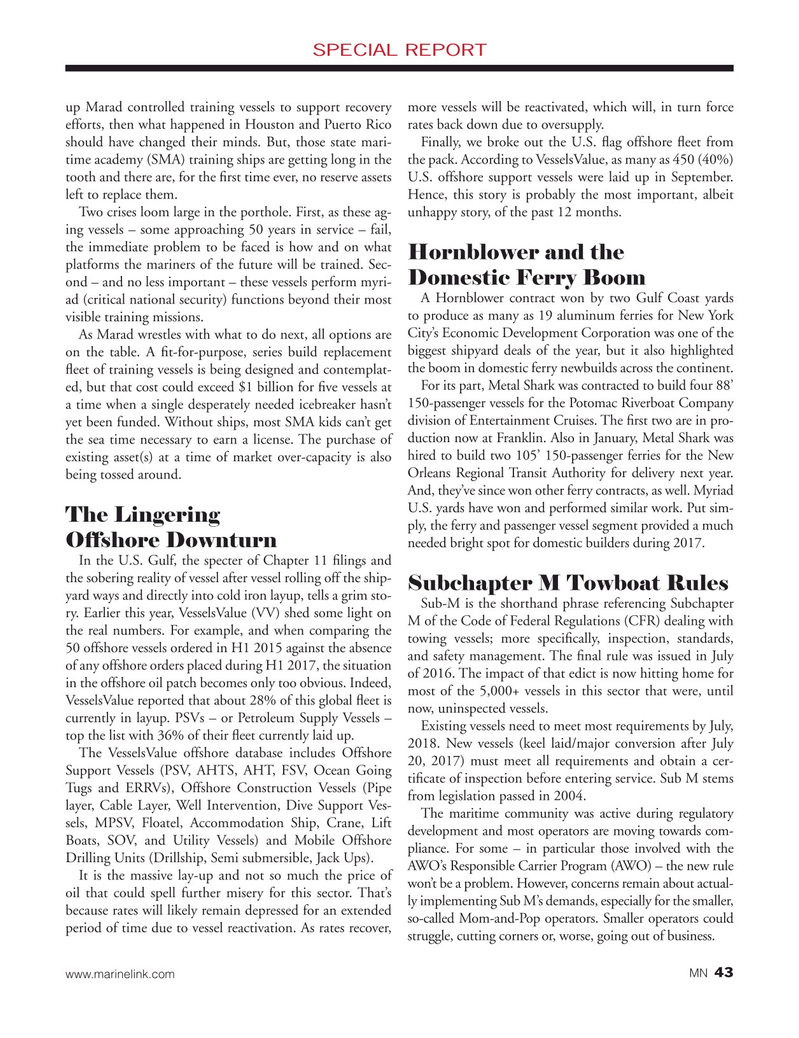
Page 43: of Marine News Magazine (December 2017)
Innovative Products & Boats- 2017
Read this page in Pdf, Flash or Html5 edition of December 2017 Marine News Magazine
SPECIAL REPORT up Marad controlled training vessels to support recovery more vessels will be reactivated, which will, in turn force efforts, then what happened in Houston and Puerto Rico rates back down due to oversupply.
should have changed their minds. But, those state mari- Finally, we broke out the U.S. ? ag offshore ? eet from time academy (SMA) training ships are getting long in the the pack. According to VesselsValue, as many as 450 (40%) tooth and there are, for the ? rst time ever, no reserve assets U.S. offshore support vessels were laid up in September. left to replace them. Hence, this story is probably the most important, albeit
Two crises loom large in the porthole. First, as these ag- unhappy story, of the past 12 months.
ing vessels – some approaching 50 years in service – fail, the immediate problem to be faced is how and on what
Hornblower and the platforms the mariners of the future will be trained. Sec-
Domestic Ferry Boom ond – and no less important – these vessels perform myri-
A Hornblower contract won by two Gulf Coast yards ad (critical national security) functions beyond their most to produce as many as 19 aluminum ferries for New York visible training missions.
As Marad wrestles with what to do next, all options are City’s Economic Development Corporation was one of the on the table. A ? t-for-purpose, series build replacement biggest shipyard deals of the year, but it also highlighted the boom in domestic ferry newbuilds across the continent.
? eet of training vessels is being designed and contemplat-
For its part, Metal Shark was contracted to build four 88’ ed, but that cost could exceed $1 billion for ? ve vessels at a time when a single desperately needed icebreaker hasn’t 150-passenger vessels for the Potomac Riverboat Company yet been funded. Without ships, most SMA kids can’t get division of Entertainment Cruises. The ? rst two are in pro- the sea time necessary to earn a license. The purchase of duction now at Franklin. Also in January, Metal Shark was existing asset(s) at a time of market over-capacity is also hired to build two 105’ 150-passenger ferries for the New
Orleans Regional Transit Authority for delivery next year. being tossed around.
And, they’ve since won other ferry contracts, as well. Myriad
U.S. yards have won and performed similar work. Put sim-
The Lingering ply, the ferry and passenger vessel segment provided a much needed bright spot for domestic builders during 2017.
Offshore Downturn
In the U.S. Gulf, the specter of Chapter 11 ? lings and the sobering reality of vessel after vessel rolling off the ship-
Subchapter M Towboat Rules yard ways and directly into cold iron layup, tells a grim sto-
Sub-M is the shorthand phrase referencing Subchapter ry. Earlier this year, VesselsValue (VV) shed some light on M of the Code of Federal Regulations (CFR) dealing with the real numbers. For example, and when comparing the towing vessels; more speci? cally, inspection, standards, 50 offshore vessels ordered in H1 2015 against the absence and safety management. The ? nal rule was issued in July of any offshore orders placed during H1 2017, the situation of 2016. The impact of that edict is now hitting home for in the offshore oil patch becomes only too obvious. Indeed, most of the 5,000+ vessels in this sector that were, until
VesselsValue reported that about 28% of this global ? eet is now, uninspected vessels.
currently in layup. PSVs – or Petroleum Supply Vessels –
Existing vessels need to meet most requirements by July, top the list with 36% of their ? eet currently laid up.
The VesselsValue offshore database includes Offshore 2018. New vessels (keel laid/major conversion after July
Support Vessels (PSV, AHTS, AHT, FSV, Ocean Going 20, 2017) must meet all requirements and obtain a cer-
Tugs and ERRVs), Offshore Construction Vessels (Pipe ti? cate of inspection before entering service. Sub M stems from legislation passed in 2004.
layer, Cable Layer, Well Intervention, Dive Support Ves-
The maritime community was active during regulatory sels, MPSV, Floatel, Accommodation Ship, Crane, Lift development and most operators are moving towards com-
Boats, SOV, and Utility Vessels) and Mobile Offshore pliance. For some – in particular those involved with the
Drilling Units (Drillship, Semi submersible, Jack Ups).
It is the massive lay-up and not so much the price of AWO’s Responsible Carrier Program (AWO) – the new rule oil that could spell further misery for this sector. That’s won’t be a problem. However, concerns remain about actual- ly implementing Sub M’s demands, especially for the smaller, because rates will likely remain depressed for an extended so-called Mom-and-Pop operators. Smaller operators could period of time due to vessel reactivation. As rates recover, struggle, cutting corners or, worse, going out of business.
43 www.marinelink.com MN

 42
42

 44
44
